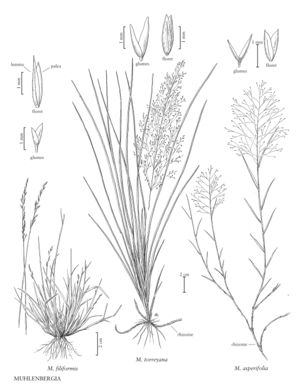Muhlenbergia torreyana
Plants perennial; rhizomatous, not cespitose. Culms 30-75 cm, compressed and keeled; internodes mostly glabrous, strigose on the keels and below the nodes. Sheaths strigose on the keels, basal sheaths much shorter than those above; ligules 0.3-1 mm, firm, truncate, ciliate; blades 6-20 cm long, 1-3.5 mm wide, conduplicate, scabrous on both surfaces, tapering to a fine sharp point. Panicles 10-28 cm long, 4-8 cm wide, cylindrical, open; primary branches 3-10 cm long, 0.05-0.1 mm thick, capillary, diverging 30-40° from the rachises, never appearing fascicled; pedicels 1.5-9 mm, usually longer than the spikelets. Spikelets 1.1-2.2 mm, occasionally with 2 florets. Glumes equal, 1-2 mm, purplish, scabridulous, 1-veined, acute, unawned; lemmas 1.1-2.2 mm, lanceolate, plumbeous, scabridulous, apices acute, unawned; paleas 1-2.1 mm, lanceolate, scabridulous, acute; anthers 1-1.4 mm, orange-yellow, turning purple at maturity. Caryopses about 1 mm, fusiform, brownish. 2n = unknown.
Distribution
Md., N.J., Del., N.C., Tenn., N.Y., Ga.
Discussion
Muhlenbergia torreyana grows in perennially wet or moist, usually seasonally inundated habitats such as the sphagnous margins of shallow ponds and seasonally wet depressions, often within pine-oak or oak barrens and at elevations of 0-150 m. Kartesz and Meacham (1999) report that it appears to have been eliminated from New York, Delaware, and Georgia but that, in addition to the locations shown on the map, it grows in Maryland and New Jersey. Hitchcock (1951) reported that it grew in Kentucky, but no specimens documenting its presence there have been located. It is rare even in those states where it is still growing.
Morphologically, Muhlenbergia torreyana resembles the western M. asperifolia but differs in its strigose, strongly compressed, keeled culms and less strongly divergent panicle branches.
Selected References
None.
